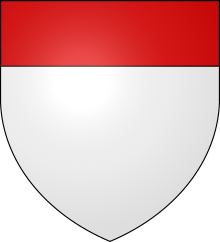Demetrius of Montferrat
Demetrius or Demetrios of Montferrat (Italian: Demetrio di Monferrato; Greek: Δημήτριος Μομφερρατικός, Dēmētrios Momferratikos), (Thessalonica, 1205 – 1230 in Amalfi), was king of Thessalonica from 1207 to 1224.

Demetrius was the son of Marquis Boniface of Montferrat by Margaret of Hungary, the widow of Emperor Isaac II Angelos. In the aftermath of the Fourth Crusade Boniface had secured for himself the kingdom of Thessalonica in the division of the spoils. Marrying the former Byzantine empress, he found it easier to attract support from the members of the Byzantine aristocracy. When Boniface's son was born in 1205, he was named after Saint Demetrius, the patron saint of Thessalonica.
Boniface was killed in a battle against the Bulgarians in 1207, and Kaloyan of Bulgaria promptly besieged Thessalonica. The siege ended with Kaloyan's murder, but Demetrius' rule was not secure. The most influential magnates of the kingdom conspired against him, plotting to replace the infant ruler with his half-brother, Marquis William VI of Montferrat. The Latin Emperor Henry of Flanders determined to stem this movement and advanced on Thessalonica in December 1208. The barons, led by Count Umberto II of Biandrate, shut the gates of the city before the emperor and issued several unreasonable demands. The emperor pretended to accept Biandrate's terms (provided that Margaret accepted them) long enough to gain entrance into the city. Margaret was instructed to overrule the terms and Henry crowned young Demetrius king on January 6, 1209 and extracted oaths of homage from the Lombard barons. The emperor's actions were confirmed by Pope Innocent III.
The rights of the young king were still threatened by Biandrate's Lombard garrisons of important fortresses like Serres and Kavala. Henry took Serres but Kavala held out. Hoping to reach a reconciliation, the emperor summoned the nobility of the Kingdom of Thessalonica to a parliament at Ravennika, but many lords did not submit. After further military action, Henry obtained the submission of Biandrate and the remaining Lombard lords. He defeated the Epirote attack on Thessalonica in 1210 and left his younger brother Eustace as regent for King Demetrius. The situation changed again on Henry's death in 1216.
The new Latin Emperor, Peter of Courtenay, was won over by the Lombard lords and invested William of Montferrat with the kingdom before leaving Italy. The Queen Mother Margaret fled to Hungary, but Demetrius apparently remained in place, while the Emperor Peter was captured and eventually executed by Theodore Komnenos Doukas in Epirus.
The ruler of Epirus, Theodore Komnenos Doukas, exploited the dissension among the nobility in Thessalonica to gradually conquer the kingdom's fortified towns one after another. Although William of Montferrat proved unwilling to dispossess his half-brother, he agreed to lead a crusade to the relief of Thessalonica in 1222, and prepared to set out, sending ahead Umberto of Biandrate. Before the main force of this crusade reached Thessalonica, however, Theodore forced the surrender of the city in December 1224. Together with the Latin archbishop, King Demetrius fled to the court of Emperor Frederick II in Italy. He participated in Frederick's crusade to the Levant, and died in 1230 at Amalfi, after ceding his rights to Thessalonica to Frederick II.
References
- Peter Lock, The Franks in the Aegean 1204–1500, New York, 1995.
- Nicolas Cheetham, Mediaeval Greece, Yale University Press, 1981.
| Preceded by Boniface |
King of Thessalonica 1207–1224 |
Conquest by Theodore of Epirus |
| New title | — TITULAR — King of Thessalonica 1224–1230 |
Succeeded by Emperor Frederick II |